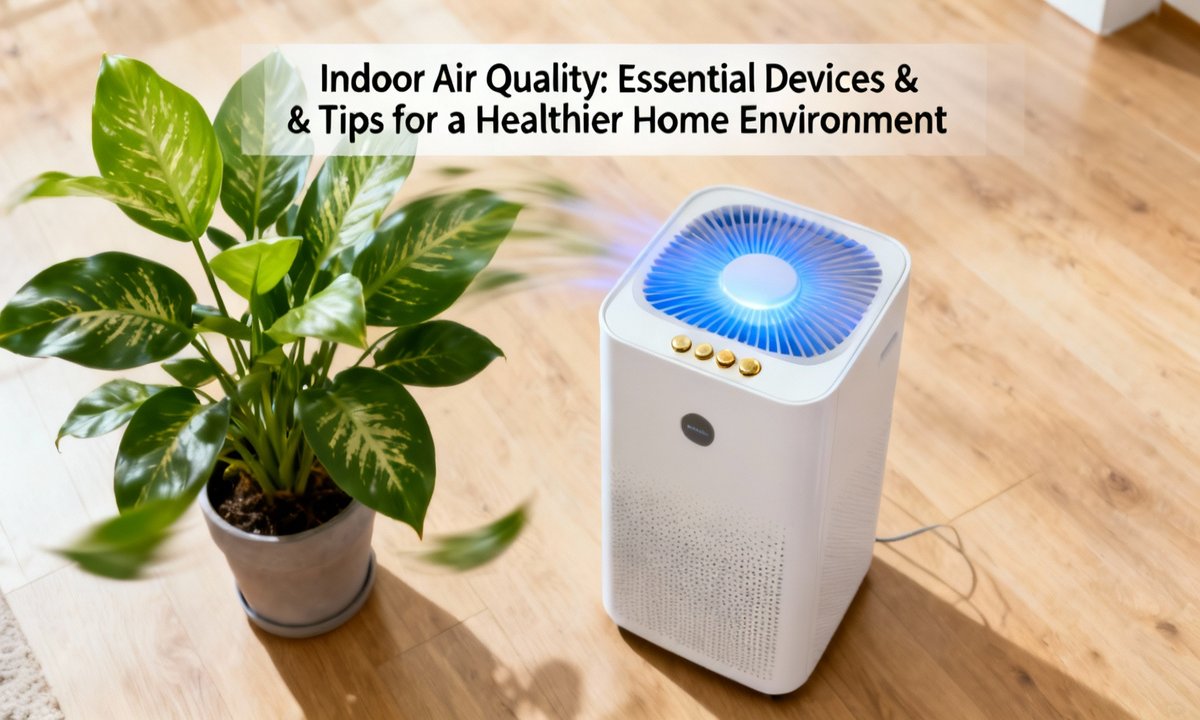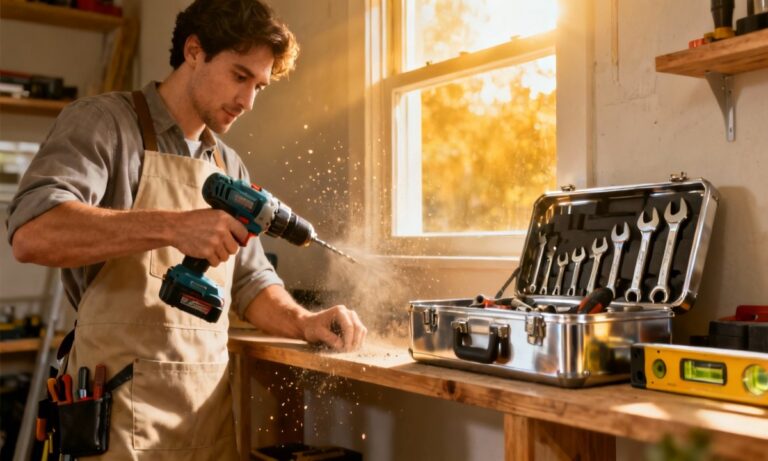Optimizing your indoor air quality is a vital step toward creating a healthier, more comfortable living space. Many may not realize that the air inside our homes can be significantly more polluted than outdoor air, a critical factor given that most individuals spend up to 90% of their time indoors. Understanding and managing these hidden pollutants is essential for overall well-being and productivity.
Harmful elements like particulates, volatile organic compounds (VOCs), and excessive humidity can trigger allergies, respiratory issues, and disrupt sleep or focus. Identifying and addressing these pollution sources is crucial for minimizing their health impacts, according to experts like the EPA, safeguarding families and those with sensitivities.
The Silent Threat: Understanding Indoor Air Quality
Why Your Home’s Air Matters More Than You Think
Advanced Solutions: Devices for Optimal Indoor Air
Smart Air Purifiers: Your First Line of Defense
Selecting an effective air purifier for your home is paramount, as their capabilities vary significantly. Focus on models equipped with True HEPA filters, capable of capturing nearly all microscopic particles, complemented by activated carbon filters for odors and VOCs. Some advanced units even incorporate UV light for enhanced germ elimination.
Key Features for 2025: HEPA, Carbon, and Smart Integration
For modern homes, prioritize smart integration. Wi-Fi enabled purifiers can monitor air quality in real-time, adjusting settings automatically for optimal performance. Leading models, as recognized by Consumer Reports, offer quiet operation, energy efficiency, and auto-sensing technology. Explore our guide on Smart Home Energy Upgrades for seamless device integration.
Real-time Insights: Air Quality Monitors
Air quality monitors are invaluable tools, detecting crucial pollutants such as particulate matter (PM2.5/PM10), VOCs, and carbon dioxide, alongside temperature and humidity. Contemporary monitors, often highlighted by HouseFresh, provide immediate readings, historical data, and smartphone alerts for proactive management.
Choosing and Placing Your Monitor for Accuracy
When selecting a monitor, emphasize accuracy, reliable app connectivity, and the ability to detect multiple pollutants. Optimal placement in high-traffic zones like living rooms, bedrooms, or near HVAC returns ensures a comprehensive overview of your home’s air. This vigilance helps identify potential issues before they compromise your family’s health. For related tips, consider our HVAC Maintenance Guide.
Balancing Act: Humidifiers and Dehumidifiers
An imbalance in humidity levels can significantly affect your indoor air quality and comfort. In arid environments or during colder months, a humidifier can alleviate respiratory dryness and protect household furnishings. Conversely, during humid seasons or in damp areas like basements, a dehumidifier actively combats mold, dust mites, and mildew.
Maintaining Ideal Humidity Levels for Health
Maintaining indoor humidity between 30% and 50% is generally recommended for optimal health. Your choice of device should align with your home’s size and local climate conditions. Modern smart humidifiers and dehumidifiers offer precise control, automating settings to ensure consistent humidity balance, which is particularly beneficial for allergy sufferers.
The Foundation: HVAC Systems and Filtration
Your HVAC air filters serve as a critical barrier against indoor pollutants. Consider upgrading to MERV 11-13 filters for superior particle capture, or integrate HEPA filters within portable systems for maximum protection. Consistent filter replacement, typically every one to three months as per manufacturer guidelines, is vital for maintaining airflow and efficiency.
Upgrading Filters and Essential Maintenance
Beyond filters, routine HVAC maintenance is indispensable. Regular air duct cleaning, unit tune-ups, and ensuring unrestricted airflow directly contribute to better indoor air quality. While some tasks, like filter changes, are suitable for DIY enthusiasts, professional servicing ensures thorough cleaning and extends system longevity. Explore our Advanced Smart Home Tech guide for more insights.
Empowering Your Home: DIY Air Improvement Strategies
Clean Home, Clean Air: Effective Dust and Allergen Control
Effective dust and allergen control begins with consistent, meticulous cleaning. Regularly dust surfaces with damp cloths and utilize HEPA-equipped vacuums for carpets, favoring hard flooring where feasible. Reducing clutter is also key, as accumulated items like books or clothing can become reservoirs for dust and pet dander.
Equipping yourself with appropriate cleaning tools simplifies this process significantly. For further insights on efficient organization and minimizing allergens, our Declutter Your Life article provides valuable tips for cultivating a tidy and low-allergen living environment.
Nature’s Touch: Simple and Sustainable Purification
Nature offers straightforward approaches to enhancing your home’s air quality. Certain houseplants, such as snake plants, spider plants, and peace lilies, can naturally absorb common toxins and contribute to balanced humidity. Additionally, embracing natural ventilation by opening windows and utilizing exhaust fans helps expel stale air and indoor pollutants.
Opt for non-toxic, low-VOC cleaning products and paints to significantly reduce chemical exposure within your home. Adopting eco-friendly solutions is a simple yet impactful step towards a healthier living space. Explore recommended alternatives in our guides on Eco-Friendly Home Products and the Eco-Friendly Cleaning Kit.
Targeting Allergens: Proactive Reduction Techniques
To mitigate breathing discomfort, consider incorporating allergy relief devices like HEPA-filter vacuums and ozone-free purifiers. Manage pet dander by regular grooming and establishing pet-free zones in bedrooms. Employ dehumidifiers strategically, particularly in basements or bathrooms, to actively prevent mold and mildew proliferation.
Vigilantly inspect your home for leaks or condensation, addressing moisture issues promptly. Should you discover persistent mold or stubborn odors, a professional air duct cleaning may be warranted; our Air Duct Cleaning Guide details the process. For targeted recommendations, especially if allergies are a concern, consult our guide on Best HEPA Air Filters for 2025.
Knowing When to Call an Expert: Professional Air Quality Assessment
Certain indicators suggest it might be time for an expert evaluation: persistent musty smells, visible mold growth, unexplained health issues such as headaches or skin irritations, or ongoing humidity challenges. Professionals leverage sophisticated indoor air quality devices to accurately diagnose problems and propose effective, targeted resolutions.
For those residing in rental properties or older homes, routine professional inspections are crucial for mitigating long-term risks and ensuring a safer environment for all occupants. For related guidance on energy management and enhancing your living space with smart technology, our Smart Home Energy Upgrades guide offers valuable insights.
Your Path to a Healthier Home Environment
Prioritizing your indoor air quality represents a significant investment in your overall health and well-being. Begin by integrating practical strategies: select appropriate air purifiers, actively monitor your air, diligently maintain HVAC systems, and incorporate natural air improvement techniques into your daily routine. This guide serves as a valuable resource for ongoing reference and sharing.
A conscientiously maintained home transcends mere cleanliness; it becomes a safer, more energy-efficient, and consistently comfortable sanctuary throughout the year. For additional strategies to enhance comfort and achieve savings, explore our exclusive article on HVAC Maintenance Tips or review sustainable practices in Eco-Friendly Home Products.
Frequently Asked Questions About Indoor Air Quality
How can I tell if my indoor air is unhealthy?
Common indicators include lingering odors, noticeable dust accumulation, recurring allergy flare-ups, or visible mold. For precise data and insights, employing an indoor air quality monitor is highly recommended.
What is the best air purifier for allergies in 2025?
When seeking an air purifier specifically for allergies, prioritize models featuring True HEPA filters, ensuring they are appropriately sized for your space. Units with activated carbon filters are beneficial, and always consult reviews from trusted consumer sources.
What are the signs I need a dehumidifier?
Key signs suggesting the need for a dehumidifier include condensation forming on windows, persistent musty smells, visible mold growth, or a general feeling of stickiness indoors. Addressing these helps maintain a balanced environment.
If this guide proved beneficial, delve deeper into specific products or home enhancements by browsing our connected articles, such as Advanced Smart Home Tech for cutting-edge advancements, or the Eco-Friendly Cleaning Kit for toxin-free essentials. Embrace cleaner air and cultivate a healthier home environment!



